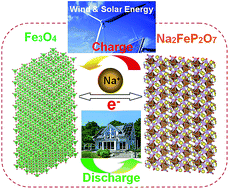A sustainable iron-based sodium ion battery of porous carbon–Fe3O4/Na2FeP2O7 with high performance
Abstract
A type of porous carbon–Fe3O4 (e.g., PC–Fe3O4) composite with an industrially scalable production was introduced in the sodium ion battery application for the first time. The PC–Fe3O4 composite, consisting of highly dispersed Fe3O4 nanocrystals within the porous carbon with a relatively low weight percent of 45.5 wt%, could efficiently demonstrate high capacities of 225, 168, 127, 103, 98 and 90 mA h g−1 under the current densities of 50, 100, 200, 300, 400 and 500 mA g−1 with a good stability over 400 cycles. The utilization co-efficient of Fe3O4 nanocrystals was proven to be much higher than most of the Fe3O4 nanoparticles reported recently via the study of the capacity contribution of carbon originally. In addition, the robustness of electrode during the charge–discharge was well characterized by ex situ XRD and emission scanning electron microscopy (SEM). More importantly, a new concept of an elemental iron-based sodium ion battery of PC–Fe3O4/Na2FeP2O7 is presented. This is the first example to introduce an element-rich configuration in the sodium ion battery from the viewpoint of sustainability. The full battery demonstrated a superior capacity of 93 mA h g−1, high capacity retention of 93.3% over 100 cycles and work voltage around 2.28 V with the energy density of 203 W h kg−1. Such configuration of an iron-based sodium battery would be highly promising and sustainable owing to its low cost and high stability in grid storage.


 Please wait while we load your content...
Please wait while we load your content...